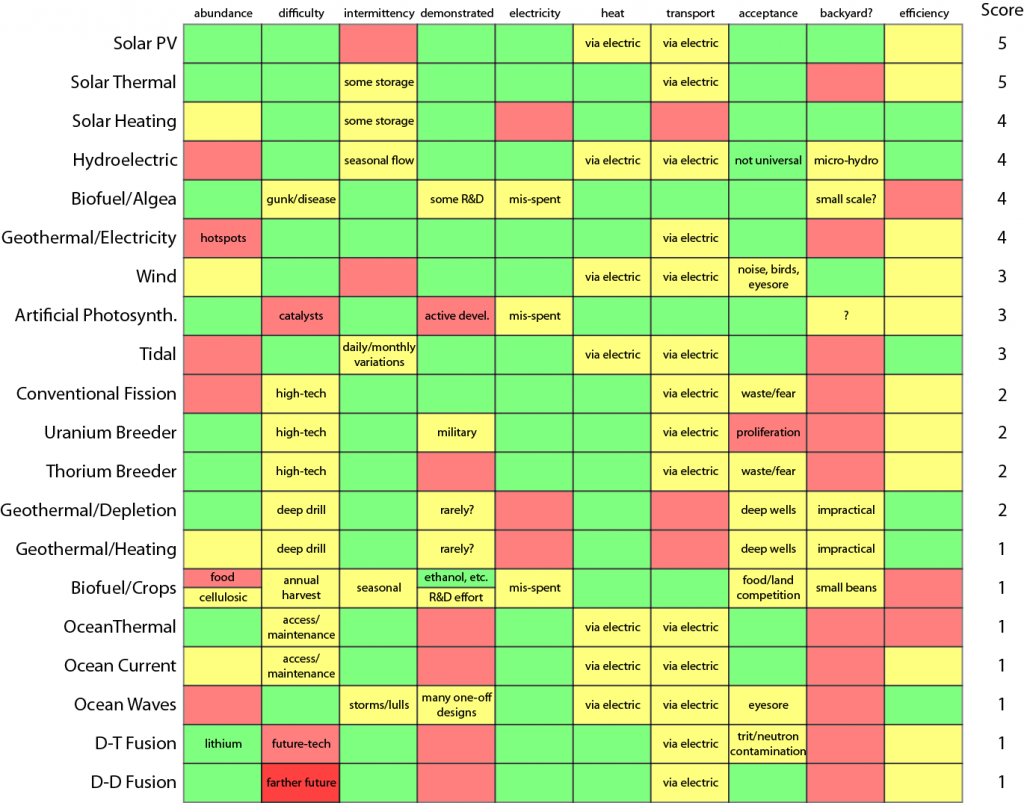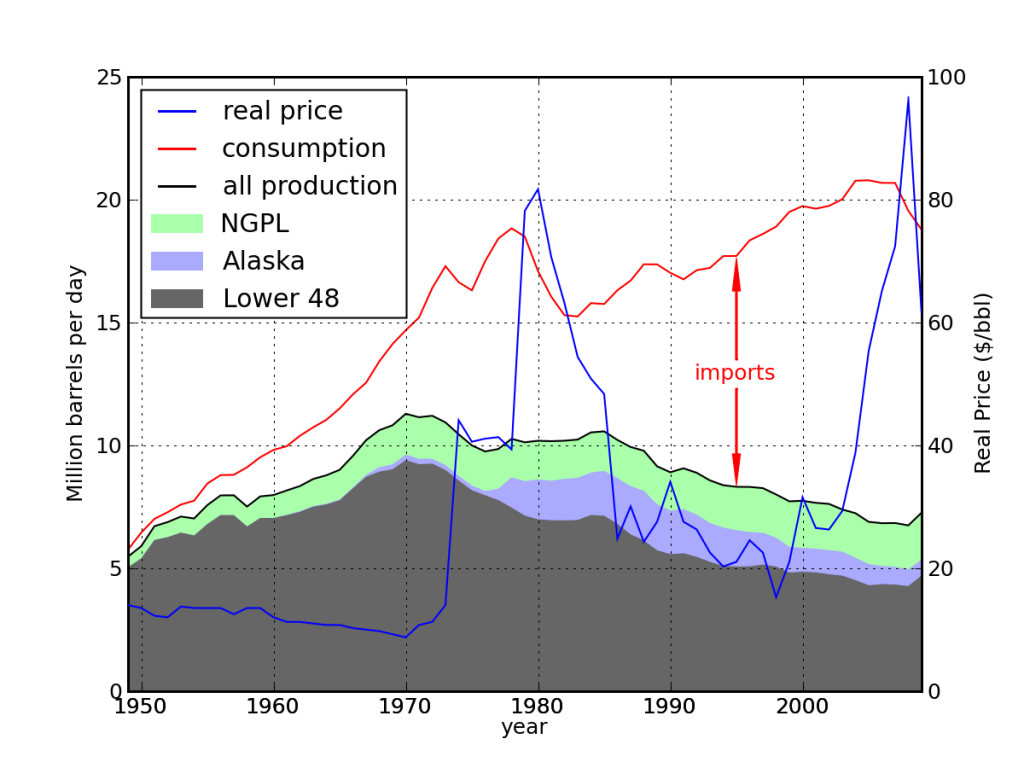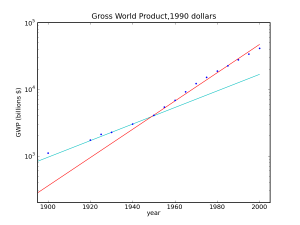Breathe, Neo. I’ve been running a marathon lately to cover all the major players that may provide viable alternatives to fossil fuels this century. Even though I have not exhausted all possibilities, or covered each topic exhaustively, I am exhausted. So in this post, I will provide a recap of all the schemes discussed thus far, in matrix form. Then Do the Math will shift its focus to more of the “what next” part of the message.
The primary “mission” of late has been to sort possible future energy resources into boxes labeled “abundant,” “potent” (able to support something like a quarter of our present demand if fully developed), and “niche,” which is a polite way to say puny. In the process, I have clarified in my mind that a significant contributor to my concerns about future energy scarcity is not the simple quantitative scorecard. After all, if it were that easy, we’d be rocking along with a collective consensus about our path forward. Some comments have asked: “If we forget about trying to meet our total demand with one source, could we meet our demand if we add them all up?” Absolutely. In fact, the abundant sources technically need no other complement. So on the abundance score alone, we’re done at solar, for instance. But it’s not that simple, unfortunately. While the quantitative abundance of a resource is key, many other practical concerns enter the fray when trying to anticipate long-term prospects and challenges—usually making up the bulk of the words in prior posts.
For example, it does not much matter that Titan has enormous pools of methane unprotected by any army (that we know of!). The gigantic scale of this resource makes our Earthly fossil fuel allocation a mere speck. But so what? Practical considerations mean we will never grab this energy store. Likewise, some of our terrestrial sources of energy are super-abundant, but just a pain in the butt to access or put to practical use.
In this post, we will summarize the ins and outs of the various prospects. Interpretation will come later. For now, let’s just wrap it all up together.
The Matrix
Would you like to know what the matrix is? Okay. I’ll tell you—in a bit. For each of the major energy hopefuls I have discussed on Do the Math, I characterize their various attributes in a three-tier classification: adequate (green); marginal (yellow); or insufficient (red)—possibly a showstopper. The scheme is qualitative, and I am sure some will disagree with my assignments. Before I go any further, let me say that I will not entertain comments griping about why I made a certain square the color I did. I won’t have time to respond at that level, given that there are 200 colored boxes in the matrix. But the beauty is, you can change the matrix any way you see fit and make your own custom version. Go buy some crayons today!. The matrix I’ve created is not without its biases and subjectivity. Whose would be?
Okay, I’ll keep the suspense going a bit by describing the fields.
Abundance: This is essentially the “abundant,” “potent,” and “niche” classification scheme reflected in the preceding posts. Green means that the resource can in principle produce far more power than we currently use and keep it up for many centuries. Red means a bit-player at best. Yellow is the stuff that can be useful, but is incapable of carrying the full load—not that we require everything to do this. We can tolerate a mix of of items, but will not get far by mixing reds together.
Difficulty: This field tries to capture the degree to which a resource brings with it large technical challenges. How many PhDs does it take to run the plant? How painful is it to maintain or keep churning? This one might translate into economic terms: difficult is another term for expensive.
Intermittency: Green if rock-steady or there whenever we need it. If the availability is beyond our control, then it gets a yellow at least. The possibility of going without for a few days earns a red.
Demonstrated: I don’t mean on paper, and I don’t mean a prototype that exhibits some of the technology. To be green, this has to be commercially available today, and providing useful energy.
Electricity: Can the technology produce electricity? Most of the time, the answer is yes. Sometimes it would make no sense to try. Other times, it is seriously impractical.
Heat: Can the resource produce direct heat? Yellow if only through electric means.
Transport: Does the technology relieve the liquid fuels crunch? Anything that makes electricity can power an electric car, earning a yellow score. Liquid fuels are green. Some may get tired of the broken record in the descriptions that follow that a particular resource does not help transportation, wanting to shout “electric cars, fool” every time I say it. But our large-scale migration to electric cars is not in the bag. They may remain too expensive to be widely adopted. Meanwhile, this does not help air travel or heavy transport.
Acceptance: Is public opinion (I can really only judge U.S. attitudes) favorable to this method? Will there likely be resistance—whether justified or not?
Backyard?: Is this something that can be done domestically, in one’s backyard or small property, managed by the individual?
Efficiency: Over 50% gets the green. Below about 10% gets red. It’s not the most important of criteria, as the abundance score incorporates efficiency expectations. But we will always view low efficiency negatively.
Okay, enough holding out—here’s the matrix (click to expand).

Yellow boxes tend to deserve explanation. It is usually clear why something would swing red or green, but yellow often has several things tugging at it. If green boxes are given a +1 score, yellow boxes zero, and red boxes -1, adding the boxes with equal weight yields the scores on the right, by which measure the table is sorted: best to worst. The only place I cheated was to give D-D fusion a -2 for difficulty. It’s the hardest thing on the list, given our decades of massive effort invested to date on D-T fusion, while D-D is too hard to even attempt.
Now, equal weighting on all ten criteria is boneheaded. But the assessment is imprecise enough not to warrant a more elaborate weighting scheme. I do not stand firm behind the order that results, and am half-tempted to monkey with weighting schemes until a more preferred order emerges. But I would be cooking the books to further match my preferences. Feel free to weight any way you see fit, and change anything else while you’re at it. Just remember. No griping.
Fossil Fuels, Compared

Note that conventional fossil fuels, matrixed-out above, score green in almost every category, except—unfortunately—abundance. The efficiency is high for direct heating (most often natural gas), and middling for electricity or transport. Coal gets no points for transportation, and natural gas is of limited use here (although the bus I’m riding as I type this is powered by natural gas, so I can’t entirely nix its transportation capability). All things considered, all of the fossil fuels get a score of 7 or 8. Note the striking gap we face between fossil fuels and their alternatives, topping out at a score of 5. One might ding the fossil fuels a point or two for their greenhouse gas contributions, closing the gap a bit. None of the options in the alternatives matrix are intrinsic carbon emitters.
Quick Lessons
Looking at some of the main trends, very few options are both abundant and easy. Solar PV and solar thermal qualify. A similar exclusion principle often holds for abundant and demonstrated/available. There is a reason why folks (myself included) like solar.
Intermittency mainly plagues solar and wind resources, with mild inconvenience appearing for many of the natural sources.
Electricity is easy to produce. We have loads of ways to do it, and are likely to pick the easiest/cheapest. We won’t necessarily get far down the list if we’re covered by things at the top end (assuming my rankings have any validity and some economic correlation).
Transport is hard. Concerns over peak oil played a huge role in making me sit up to pay attention to our energy challenges. Electric cars are the most obvious way out, but don’t do much for heavy shipping by land or sea, and leave airplanes on the ground.
Few things face serious barriers to acceptance: especially when energy scarcity is at stake.
A few options are available for the homestead. A passive solar home with PV panels, wind, and some method to produce liquid fuels on site would be a dream come true. Here’s hoping for artificial photosynthesis!
The missing category here is cost, although difficulty may be an imperfect proxy. As a result, some of the high-scoring options may more be costly than we’d like. Actually, some of the lowest-scoring options are the costliest! If you’re expecting that we’ll replace fossil fuels and do it on the cheap, you might as well learn to bawl on the floor kicking and pounding your fists, tears streaming. This is our predicament. We have to buck up and deal with it, somehow.
Individual Discussion
For each topic, the link at the beginning points to a more complete discussion on Do the Math. Here, I just briefly characterize each resource in relation to the matrix criteria.
Solar PV: Covering only 0.5% of land area with 15% efficient PV panels provides the annual energy needs of our society, qualifying solar PV as abundant. It’s not terribly difficult to produce; silicon is the most abundant element in Earth’s crust, and PV panels are being produced globally at 25 GW peak capacity per year (translating to 5 GW of average power added per year). Intermittency is the Achilles Heel of solar PV, requiring storage solutions if adopted at large scale. Solar PV produces electricity directly, which could be converted to heat or transport. Most people do not object to solar PV on rooftops or over parking areas, or even in open spaces (especially desert). I’ve got some on my garage roof as we speak (with storage), so they’re well-suited to individual operation/maintenance. Clocking in at an efficiency of 15%, don’t expect PV to vastly exceed this ballpark.
Solar Thermal: Achieving comparable efficiency to PV, but using more land area, generating electricity from concentrated solar thermal energy automatically fits in the abundant category—though somewhat more regionally constrained. It’s relatively low-tech: shiny curved mirrors tracking on (often) one axis, heating oil or other fluid to run a plain-old heat engine. Intermittency can be mitigated by storing thermal energy, perhaps even for a few days. Because a standard heat-engine follows, fossil fuels can supplement in lean times using the same back-end. A number of plants are already in operation, producing cost-competitive electricity—and heat if anyone cares. As with so many of the alternatives, transportation is not directly aided. Public acceptance is no worse than for PV, etc. But don’t expect your own personal solar thermal electricity plant.
Solar Heating: On a smaller scale, heat collected directly from the sun can provide domestic hot water and home heating. In the latter case, it can be as simple as a south-facing window. Capturing and using solar heat effectively is not particularly difficult, coming down to plumbing, insulation, and ventilation control. Technically, it might be abundant, but since it is usually restricted to building footprints (roof, windows), I take it down a notch. There will be lean days, but my friends in Maine do not complain about their solar heating comfort (with occasional propane backup). Solar heating is useless for electricity or transport, but has no difficulty being accepted and almost by definition is a backyard-ready technology.
Hydroelectric: We have seen that super-efficient hydroelectric is doomed to remain a small player (in the rubric that we maintain today’s energy consumption levels). It’s the low-hanging fruit of the renewable world, and has therefore already seen large-scale development. It has seasonal intermittency (typical capacity factor for a hydro plant is 40%), does not directly provide heat or transport, and can only rarely be implemented personally, at home. Acceptance is fairly high, although silting and associated dangers—together with habitat destruction—do cause some opposition to expanded hydroelectricity.
Biofuels from Algae: I was somewhat surprised to see this entry rank as highly as it did in my admittedly unsophisticated scoring scheme. Because it captures solar energy—even at < 5% efficiency—the potential scale is automatically enormous. But it’s not easy, at present. Dealing with slime will bring challenges of keeping the plumbing clean, possible infection in a genetic arms race with evolving viruses, contamination by other species, etc. At present, we don’t have that magic algal sample that secretes the fuels we want. Heady talk of genetic engineering pledges to solve these problems, but we’re simply not there yet and cannot say for sure that we will get there. Otherwise, the ability to provide transportation fuel is the big draw. Heat may also be efficiently produced, though electricity would represent a misallocation of liquid fuel. Can it be done in the backyard? I could imagine a slime pond in the yard, but care and feeding and refining the product may be prohibitively difficult.
Geothermal Electricity: This option makes sense primarily at geological hotspots, which are rare. It will not scale to be a significant part of our entire energy mix. Aside from this, it is relatively easy, steady, and well-demonstrated in many locations. It can provide electricity, and obviously direct heat—although far from heat demand, generally. It provides no direct help on transportation. Objections are slim to non-existent. I don’t think houses tend to be built on the hotspots, so don’t look for it in a backyard near you.
Wind: Wind is a sensible option that I imagined would float higher in the list than it did. It’s neither abundant nor scarce, being one of those options that can provide a considerable fraction of our present needs under large-scale development. It’s pretty straightforward, reasonably efficient, and demonstrated the world over in large farms. The biggest downside is its intermittency. It will not be unusual to have a few days in a row with little or no regional input. Like so many other things, electricity is naturally produced, while heat and transport is only available via electricity. I sense that objections to wind are more serious than for many other alternatives. Windmills are noisy and tend to be located in prominent places (ridge-tops) where they are extremely visible and scenery-altering. You can’t hide wind in a bowl, or you end up hiding from the wind at the same time. Another built-in conflict emerges on wind-rich coastlines, where many like to take in unspoiled scenery. Small-scale wind is viable in your own backyard.
Artificial Photosynthesis: A very appealing future prospect for me is artificial photosynthesis, combining the abundance of direct solar with the self-storing flexibility of liquid fuel. Intermittency is thus eliminated to the extent that annual production meets demand: storage of a liquid fuel for many months is possible. The dream result of a panel sitting on your roof that drips liquid fuel could provide both heating and transportation fuel. In a pinch, one could also produce electricity this way, but what a waste of precious liquid fuel, when we have so many other ways to make electricity! The catch is that it doesn’t exist yet, that it may never exist, and that feeding it the right ingredients and processing/refining the fuel may eliminate the backyard angle. Still, we all have to have something to gush over. For some, it’s thorium and for others it’s fusion, etc. This one excites me by its potential to satisfy so many purposes.
Tidal Power: Restricted to select coastal locations, tidal will never be a large contributor on the global scale. The resource is intermittent on daily and monthly scales, but in a wholly predictable manner. Extracting tidal energy is not terribly hard—sharing technology with similarly efficient hydroelectric installations—and has been demonstrated in a number of locations around the world. It’s another electricity technique, with no direct offering of heat or transportation. No unusual level of societal objection exists, to my knowledge, but it’s not something you will erect in your backyard and expect to get much out of it.
Conventional Fission: Using conventional uranium reactors and conventional mining practices, nuclear fission does not have the legs for a marathon. On the other hand, it is certainly well-demonstrated, and has no problems with intermittency—unless we count the fact that it has trouble being intermittent in the face of variable load. Compared to other options, nuclear runs a tad on the high-tech side. By this I mean that design, construction, operation, and emergency mitigation require more brains and sophistication than the average energy producer. Nuclear fission directly produces heat (seldom utilized), and is primarily used to generate electricity via the standard steam-driven heat engine, but offers no direct help on transportation. Acceptance is mixed. Germany plans to phase out its nuclear program even though they are serious about carbon reduction. No new plants have been built in the U.S. for over thirty years in part due to public discomfort. Some of this is irrational fear over mutant three-eyed fish and the like, but some is genuine political difficulty relating to the pesky waste problem that no country has yet solved to satisfaction. Nuclear power is not possible on a personal scale.
Uranium Breeder: Extending nuclear fission to be able to use the 140-times more abundant 238U (rather than 0.7% 235U) gives uranium fission the legs to run for at least centuries if not a few millennia, so abundance issues disappear. Breeding has been practiced in military reactors, and indeed some significant fraction of the power in conventional uranium reactors comes from 238U turned 239Pu. But no commercial power plants have been built to deliberately access the bulk of uranium, turning it into plutonium at scale for the purpose of power production. Public acceptance of breeders will face even stiffer hurdles because plutonium is more easily separated into bomb material than is 235U, and the trans-uranic radioactive waste from this option is nastier than for the conventional cousin.
Thorium Breeder: Thorium is more abundant than uranium, and only comes in one flavor naturally, so that abundance is not an issue. Like all reactors, thorium reactors fall into the high-tech camp, and include new challenges (e.g., liquid sodium) that conventional reactors have not faced. There have been a few instances of small-scale demonstration, but nothing in the commercial realm, so that we’re probably a few decades away from being able to bring thorium online. Public reaction will be likely be similar to that for conventional nuclear: not a show stopper, but some resistance on similar grounds. It is not clear whether the newfangled aspect of thorium will be greeted with suspicion or with an embrace. Though also a breeding technology (making fissile 233U from 232Th), the proliferation aspect is severely diminished for thorium due to highly radioactive 232U by-product and virtually no easily separable plutonium. Of the future nuclear prospects, I am most optimistic about this one—although it’s no nirvana to me.
Geothermal Heating with Depletion: A vast store of thermal energy sits in the crust, locked in the rock and moving slowly outward. Being the impatient lot that we are, we could drill down and grab the energy out of the rock on our own schedule, effectively mining heat as a one-time resource. In the absence of water flow to convect heat around, dry rock will deplete its heat within 5–10 meters of the borehole in a matter of a few years, requiring another hole 10 meters away from the first, and so on and so on. I classify this as moderately difficult, requiring a never-ending large-scale drilling operation across the land. The temperatures are pretty marginal for running heat engines to make electricity with any respectable efficiency (especially given so many easier options for electricity), but at least the thermal resource will not suffer intermittency problems during the time the hole is still useful. Given its inconvenience (kilometers of drilling), I do not know if examples abound of people having tried this for the purpose of providing heat in arbitrary (not geologically hot) areas. Public acceptance may be less than lukewarm given the scale of drilling involved, dealing with tailings and possibly groundwater contamination issues on a sizable scale. While such a hole could fit in a backyard, it would be far more practical to use the heat for clusters of buildings rather than for just one—given the amount of effort that goes into each hole (and considering short-term lifetime of each hole). I gave this technique high marks for efficiency if used for heat, but it would drop to reddish-yellow if we tried to use this resource for electricity.
Geothermal Heating, Steady State: If we turn our noses up at depletion-based geothermal heat, steady state offers far less total potential, coming to about 10 TW of flow if summed acrossall land. And to access temperatures hot enough to be useful for heating purposes, we’re talking about boreholes at least 1 km deep. It is tremendously challenging to cover any significant fraction of land area with thermal collectors 1 km deep. So I am probably being too generous to color this one yellow for the abundance factor. That’s okay, because I’m hitting it hard enough on the other counts. To gather enough steady-flow heat to provide for a normal U.S. home’s heat, the collection network would have to span a square 200 m on a side at depth, which seems nightmarish to me. But at least depletion would not be an issue in this circumstance. Otherwise, this category shares similar markings and rationale as the depletion scenario.
Biofuels from Crops: We’ve seen that corn ethanol is a loser of a scheme on energy grounds, although sugar cane and vegetable oils fare better. But these compete with food production and arable land availability, so biofuels from crops can only graduate from “niche” to “potent” in the context of plant waste or cellulosic conversion. I have thus split the abundance and demonstration in two: food crop energy is demonstrated but severely constrained in scale. Celluosic matter becomes a potent source, but undemonstrated (perhaps this should even be red). I do not label the prospect as an easy one, because growing and harvesting annual crops on a relavent scale constitutes a massive, perpetual job. If exploiting fossil fuels is akin to spending our inheritance, growing and harvesting our energy on an annual basis is like getting a real job—a real hard job. The main benefit of biofuels from crops is that we get a liquid fuel out of it—so hard to come by via other alternatives. Public acceptance hinges on competition with food or just land in general. Scoring only about 1% efficient at raking in solar energy, this option requires commandeering massive tracts of land. A small-time farmer may make useful amounts of fuel for themselves in their back “yard,” if refining does not create a bottleneck.
Ocean Thermal: The ocean thermal resource uses the 20–30°C temperature difference between the deep ocean (a few hundred meters down) and its surface to drive a ridiculously low-efficiency heat engine. The heat content is not useful for warming any home (it’s not hot). But all the same, it’s a vast resource due to the sheer area of the solar collector. Large plants out at sea will be difficult to access and maintain, and transmitting power to land is no picnic either. The resource suffers seasonal intermittency at mid-latitudes, but let’s imagine putting these things all in the tropics to get around this. Sound hard, you say? Well yeah! That’s part of what makes ocean thermal difficult! No relevant/commercial scale demonstration exists. Like so many others, this is electricity only (and this time, far from demand). Probably nobody cares what we put to sea: out of sight, out of mind. Ocean thermal isnot a backyard solution!
Ocean Currents: Large-scale oceanic currents are slower than wind by about a factor of ten, giving a kilogram of current 1000 times less power than a kilogram of wind. Water density makes up the difference to make ocean current comparable to wind in terms of power per rotor area. Not all the ocean has currents as high as 1 m/s, so I put the total abundance in the same category as wind. Maybe accessing a thicker column of water than we can for wind should bump ocean currents up a bit, but the currents are relatively confined to surfaces. But why dunk a windmill underwater where it’s far from demand and difficult to access and maintain, when a comparable power can be had in dry air? So I classify this as difficult. On the plus side, the current should be rock solid, eliminating intermittency worries, unlike wind. Still, not one bit of our electricity mix comes from ocean currents at present, so it cannot be said to have been meaningfully demonstrated. For the remaining categories: it’s electricity only; who cares what’s underwater; and no backyard opportunity.
Ocean Waves: While they seem strong and ever-present, waves are a linear-collection phenomenon, and not an areal phenomenon. So there really isn’t that much arriving at shores all around the world (a few TW at best). It’s not particularly difficult to turn wave motion into useful electricity at high efficiency, and the proximity to land will make access, maintenance, and transmission far less worrisome than for the previous two cases. There will be some intermittency—largely seasonal— as storms and lulls come and go. I’ve seen a diverse array of prototype concepts, and a few are being tested at commercial scale. So this is further along then the previous two oceanic sources, but not so much as to get the green light. There will be moderate push-back from people whose ocean views are spoiled, or who benefit from natural wave energy hitting the coast. There are no waves in my backyard, and I hope to keep it this way!
D-T Fusion: The easier of the two fusion options, involving deuterium and tritium, represents a longstanding goal under active development for the last 60 years. The well-funded international effort, ITER, plans to accomplish a 480 second pulse of 500 MW power by 2026. This defines the pinnacle of hard. Fusion brings with it numerous advantages: enormous power density; moderate radioactive waste products (an advantage?!); abundant deuterium (though tritium is zilch); and surplus helium to liven up children’s parties. Fusion would have no intermittency issues, can directly produce heat (and derivative electricity), but like the others does not directly address transportation. The non-existant tritium can be knocked out of lithium with neutrons, and even through we are not awash in lithium, we have enough to last many thousands of years. We might expect some public opposition to D-T fusion due to the necessary neutron flux and associated radioactivity. Fusion is the highest-tech energy we can envision at present, requiring a team of well-educated scientists/technicians to run—meaning don’t plan on building one in your backyard, unless you can afford to have some staff PhDs on hand.
D-D Fusion: Replacing tritium with deuterium means abundance of materials is no concern whatsoever for many billions of years. As a trade, it’s substantially harder than D-T fusion (or we would not even consider D-T). D-D fusion requires higher temperatures, making confinement that much more difficult. It is for this reason that I gave D-D fusion a -2 score for difficulty. It’s not something we should rely upon to get us out of the impending energy pinch, which is my primary motivation.
End of an Era
Not only does this conclude the end of the phase on Do the Math where we evaluate the quantitative and qualitative benefits and challenges of alternatives to fossil fuels, it also points to the fact that we face the end of a golden era of energy. Sure, we managed to make scientific and cultural progress based on energy from animals, slaves, and firewood prior to discovering the fossil fuels. But it was in unlocking our one-time inheritance that we really came into our own. Soon, we will see a yearly decrease in our trust fund dividend, forcing us to either adapt to less or try to fill the gap with replacements. What this post and the series preceding it demonstrates is that we do not have a delightful menu from which to select our future. Most of the options leave a bad taste of one form or the other.
When I first approached the subject of energy in our society, I expected to develop a picture in my mind of our grandiose future, full of alternative energy sources like solar, wind, nuclear, biofuels, geothermal, tidal, etc. What I got instead was something like this matrix: full of inadequacies, difficulties, and show-stoppers. Our success at managing the transition away from fossil fuels while maintaining our current standard of living is far from guaranteed. If such success is our goal, we should realize the scale of the challenge and buckle down now while we still have the resources to develop a costly new infrastructure. Otherwise we get behind the curve, possibly facing unfamiliar chaos, loss of economic confidence, resource wars, and the unforgiving Energy Trap. The other controlled option is to deliberately adjust our lives to require fewer resources, preferably abandoning the growth paradigm at the same time. Can we manage a calm, orderly exit from the building? In either case, the first step is to agree that the building is in trouble. Techno-optimism keeps us from even agreeing on that.
Tom Murphy is an associate professor of physics at the University of California, San Diego. An amateur astronomer in high school, physics major at Georgia Tech, and PhD student in physics at Caltech, Murphy has spent decades reveling in the study of astrophysics. He currently leads a project to test General Relativity by bouncing laser pulses off of the reflectors left on the Moon by the Apollo astronauts, achieving one-millimeter range precision. Murphy’s keen interest in energy topics began with his teaching a course on energy and the environment for non-science majors at UCSD. Motivated by the unprecedented challenges we face, he has applied his instrumentation skills to exploring alternative energy and associated measurement schemes. Following his natural instincts to educate, Murphy is eager to get people thinking about the quantitatively convincing case that our pursuit of an ever-bigger scale of life faces gigantic challenges and carries significant risks.
![]()

![]()
![]()
![]()
![]()
![]()
![]()
![]()
![]()
![]()
![]()
![]()
![]()
![]()
![]()
![]()
![]()
![]()
![]()
![]()
![]()
![]()
![]()
![]()
![]()
![]()
















 So far on Do the Math, I’ve put out a lot of negative energy—whatever that means. Topics have often focused on what we can’t do, or at least on the failings or difficulties of various ambitious plans. We can’t expect indefinite growth—whether in energy, population, or even growth of the
So far on Do the Math, I’ve put out a lot of negative energy—whatever that means. Topics have often focused on what we can’t do, or at least on the failings or difficulties of various ambitious plans. We can’t expect indefinite growth—whether in energy, population, or even growth of the  Jennifer Francis is a research professor at the Institute of Marine and Coastal Sciences at Rutgers University, where she studies Arctic climate change and the link between Arctic and global climates. She has authored more than 40 peer-reviewed publications on these topics. She was also the co-founder of the Rutgers Climate and Environmental Change Initiative.
Jennifer Francis is a research professor at the Institute of Marine and Coastal Sciences at Rutgers University, where she studies Arctic climate change and the link between Arctic and global climates. She has authored more than 40 peer-reviewed publications on these topics. She was also the co-founder of the Rutgers Climate and Environmental Change Initiative.

 Annie Leonard is one of the most articulate, effective champions of the commons today. Her webfilm
Annie Leonard is one of the most articulate, effective champions of the commons today. Her webfilm 
